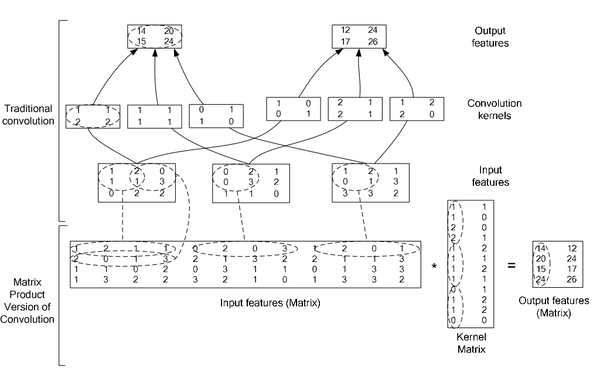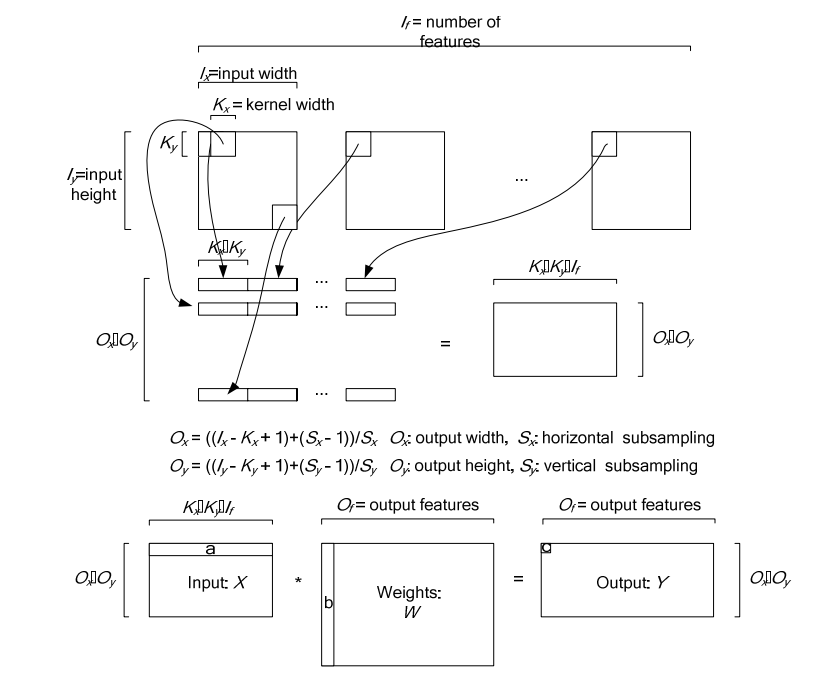Caffe源码解析5:Conv_Layer
2017-07-16 00:20
519 查看
转自楼燚(yì)航的blog,http://home.cnblogs.com/louyihang-loves-baiyan/
Vision_layer里面主要是包括了一些关于一些视觉上的操作,比如卷积、反卷积、池化等等。这里的类跟data layer一样好很多种继承关系。主要包括了这几个类,其中CuDNN分别是CUDA版本,这里先不讨论,在这里先讨论ConvolutionLayerBaseConvolutionLayer
ConvolutionLaye
DeconvolutionLayer
CuDNNConvolutionLayer
Im2colLayer
LRNLayer
CuDNNLRNLayer
CuDNNLCNLayer
PoolingLayer
CuDNNPoolingLayer
SPPLayer
这里我画了一个类图,将关系梳理了一下:

BaseConvolutionLayer
其继承自Layer,是一个卷积以及反卷积操作的基类,首先我们来看BaseConvolutionLayer的LayerSetUp函数void BaseConvolutionLayer<Dtype>::LayerSetUp(const vector<Blob<Dtype>*>& bottom, const vector<Blob<Dtype>*>& top) //首先这里主要是在配置卷积kernel 的size,padding,stride以及inputs ConvolutionParameter conv_param = this->layer_param_.convolution_param(); force_nd_im2col_ = conv_param.force_nd_im2col(); channel_axis_ = bottom[0]->CanonicalAxisIndex(conv_param.axis()); const int first_spatial_axis = channel_axis_ + 1; const int num_axes = bottom[0]->num_axes(); num_spatial_axes_ = num_axes - first_spatial_axis; CHECK_GE(num_spatial_axes_, 0); vector<int> bottom_dim_blob_shape(1, num_spatial_axes_ + 1); vector<int> spatial_dim_blob_shape(1, std::max(num_spatial_axes_, 1)); // 设置kernel的dimensions kernel_shape_.Reshape(spatial_dim_blob_shape); int* kernel_shape_data = kernel_shape_.mutable_cpu_data();
接着是设置相应的stride dimensions,对于2D,设置在h和w方向上的stride,代码太长列出简要的
pad_.Reshape(spatial_dim_blob_shape); int* pad_data = pad_.mutable_cpu_data(); pad_data[0] = conv_param.pad_h(); pad_data[1] = conv_param.pad_w(); ......一堆if else判断
对于kernel的pad也做相应设置
pad_.Reshape(spatial_dim_blob_shape); int* pad_data = pad_.mutable_cpu_data(); pad_data[0] = conv_param.pad_h(); pad_data[1] = conv_param.pad_w();
接下来是对widhts 和bias左设置和填充,其中blob[0]里面存放的是filter weights,而blob[1]里面存放的是biases,当然biases是可选的,也可以没有
//设置相应的shape,并检查
vector<int> weight_shape(2);
weight_shape[0] = conv_out_channels_;
weight_shape[1] = conv_in_channels_ / group_;
bias_term_ = this->layer_param_.convolution_param().bias_term();
vector<int> bias_shape(bias_term_, num_output_);
//填充权重
this->blobs_[0].reset(new Blob<Dtype>(weight_shape));
shared_ptr<Filler<Dtype> > weight_filler(GetFiller<Dtype>(
this->layer_param_.convolution_param().weight_filler()));
weight_filler->Fill(this->blobs_[0].get());
//填充偏置项
if (bias_term_) {
this->blobs_[1].reset(new Blob<Dtype>(bias_shape));
shared_ptr<Filler<Dtype> > bias_filler(GetFiller<Dtype>(
this->layer_param_.convolution_param().bias_filler()));
bias_filler->Fill(this->blobs_[1].get());
}
ConvolutionLayer
ConvolutionLayer继承了BaseConvolutionLayer,主要作用就是将一副image做卷积操作,使用学到的filter的参数和biaes。同时在Caffe里面,卷积操作做了优化,变成了一个矩阵相乘的操作。其中有两个比较主要的函数是im2col以及col2im。图中上半部分是一个传统卷积,下图是一个矩阵相乘的版本

下图是在一个卷积层中将卷积操作展开的具体操作过程,他里面按照卷积核的大小取数据然后展开,在同一张图里的不同卷积核选取的逐行摆放,不同N的话,就在同一行后面继续拼接,不同个可以是多个通道,但是需要注意的是同一行里面每一段都应该对应的是原图中中一个位置的卷积窗口。

对于卷积层中的卷积操作,还有一个group的概念要说明一下,groups是代表filter 组的个数。引入gruop主要是为了选择性的连接卷基层的输入端和输出端的channels,否则参数会太多。每一个group 和1/ group的input 通道和 1/group 的output通道进行卷积操作。比如有4个input, 8个output,那么1-4属于第一组,5-8属于第二个gruop
ConvolutionLayer里面,主要重写了Forward_cpu和Backward_cpu
void ConvolutionLayer<Dtype>::Forward_cpu(const vector<Blob<Dtype>*>& bottom,
const vector<Blob<Dtype>*>& top) {
const Dtype* weight = this->blobs_[0]->cpu_data();
for (int i = 0; i < bottom.size(); ++i) {
const Dtype* bottom_data = bottom[i]->cpu_data();
Dtype* top_data = top[i]->mutable_cpu_data();
for (int n = 0; n < this->num_; ++n) {
this->forward_cpu_gemm(bottom_data + n * this->bottom_dim_, weight,
top_data + n * this->top_dim_);
if (this->bias_term_) {
const Dtype* bias = this->blobs_[1]->cpu_data();
this->forward_cpu_bias(top_data + n * this->top_dim_, bias);
}
}
}
}可以看到其实这里面他调用了forward_cpu_gemm,而这个函数内部又调用了math_function里面的caffe_cpu_gemm的通用矩阵相乘接口,GEMM的全称是General Matrix Matrix Multiply。其基本形式如下:
C=alpha∗op(A)∗op(B)+beta∗C,C=alpha∗op(A)∗op(B)+beta∗C,
template <typename Dtype>
void ConvolutionLayer<Dtype>::Backward_cpu(const vector<Blob<Dtype>*>& top,
const vector<bool>& propagate_down, const vector<Blob<Dtype>*>& bottom) {
//反向传播梯度误差
const Dtype* weight = this->blobs_[0]->cpu_data();
Dtype* weight_diff = this->blobs_[0]->mutable_cpu_diff();
for (int i = 0; i < top.size(); ++i) {
const Dtype* top_diff = top[i]->cpu_diff();
const Dtype* bottom_data = bottom[i]->cpu_data();
Dtype* bottom_diff = bottom[i]->mutable_cpu_diff();
//如果有bias项,计算Bias导数
if (this->bias_term_ && this->param_propagate_down_[1]) {
Dtype* bias_diff = this->blobs_[1]->mutable_cpu_diff();
for (int n = 0; n < this->num_; ++n) {
this->backward_cpu_bias(bias_diff, top_diff + n * this->top_dim_);
}
}
//计算weight
if (this->param_propagate_down_[0] || propagate_down[i]) {
for (int n = 0; n < this->num_; ++n) {
// 计算weights权重的梯度
if (this->param_propagate_down_[0]) {
this->weight_cpu_gemm(bottom_data + n * this->bottom_dim_,
top_diff + n * this->top_dim_, weight_diff);
}
//计算botttom数据的梯度,下后传递
if (propagate_down[i]) {
this->backward_cpu_gemm(top_diff + n * this->top_dim_, weight,
bottom_diff + n * this->bottom_dim_);
}
}
}
}
}
相关文章推荐
- Caffe源码解析5:Conv_Layer
- Caffe源码解析5:Conv_Layer
- Caffe源码解析4: Data_layer
- Caffe源码解析3:Layer
- caffe源码解析-inner_product_layer
- caffe源码解析之Layer层(1)
- Caffe源码解析4: Data_layer
- Caffe源码解析6:Neuron_Layer
- Caffe源码解析6:Neuron_Layer
- caffe源码解析—caffe layer的工作原理理解
- Caffe源码解析7:Pooling_Layer
- Caffe源码解析3: Data_layer
- caffe源码:base_conv_layer
- Caffe源码解析7:Pooling_Layer
- Caffe源码解析7:Pooling_Layer
- Caffe源码解析3:Layer
- Caffe源码解析3:Layer
- caffe源码解析-BaseConvolutionLayer
- Caffe源码解析3:Layer
- caffe源码-conv_layer
